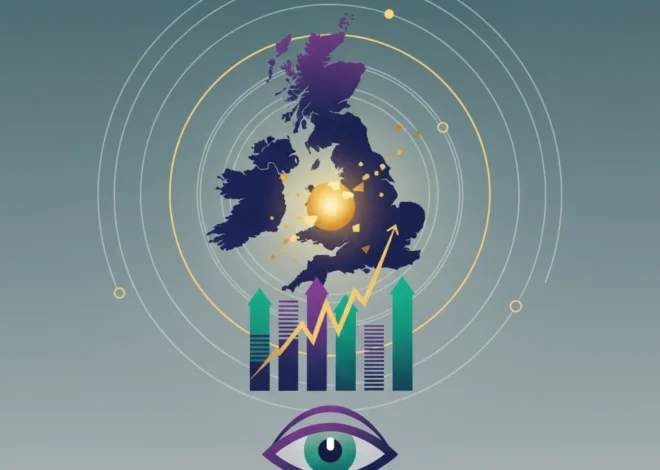
The Billion-Pound Question: Are UK Banks About to Foot the Nation’s Bill?
The End of the Profit Picnic?
In the world of finance, few things are as reliable as the cyclical nature of booms and busts. For UK banks, the last two years have been an undisputed boom. As interest rates soared from historic lows to levels not seen in over a decade, the banking sector found itself hosting a rather lavish “profit picnic.” The main course? Sky-high Net Interest Margins (NIMs)—the profitable gap between what banks earn on loans and what they pay out on deposits. But as the UK economy braces for a potential change in government, a new question is being served: is it time for the banks to share their meal?
The UK’s shadow chancellor, Rachel Reeves, is facing the monumental task of balancing the nation’s books. With a significant fiscal hole to fill, every sector is under scrutiny. The banking industry, with its gleaming pre-tax profits, presents a particularly tempting target. The debate is no longer *if* the government needs more revenue, but *from where* it will come. This sets the stage for a high-stakes confrontation between political necessity and the financial stability of the City of London, with profound implications for the economy, investors, and the future of UK banking.
Anatomy of a Windfall: How Interest Rates Fuelled a Banking Bonanza
To understand why banks are in the government’s crosshairs, we need to look at the mechanics of modern banking. When a central bank, like the Bank of England, raises its base rate to combat inflation, commercial banks benefit almost instantly. They can charge more for mortgages, personal loans, and business credit. However, the rate they pass on to savers for their deposits often lags, widening their Net Interest Margin. This isn’t a new phenomenon in economics, but the speed and scale of the recent rate hikes have supercharged the effect.
The numbers are staggering. The UK’s top four high street banks—Lloyds, NatWest, Barclays, and HSBC—collectively reported pre-tax profits nearing £45 billion in the last year. This surge in profitability has been a boon for investors, funding generous dividend payouts and share buyback programs, which in turn support stock market valuations. Yet, this same success makes them a prime candidate for fiscal intervention.
Here’s a look at the profit landscape for some of the UK’s major banking players, illustrating the scale of the funds in question.
| Banking Group | Reported Pre-Tax Profit (Approx.) | Key Driver |
|---|---|---|
| HSBC | £24bn (Global) | Strong performance in UK and international markets, boosted by higher interest rates. |
| NatWest Group | £6.2bn | Significant increase in net interest income driven by the UK rate environment. |
| Lloyds Banking Group | £7.5bn | Robust net interest margin and strong mortgage book performance. |
| Barclays | £6.6bn | Diversified income from both UK retail banking and its international investment bank. |
Note: Figures are based on recent annual reports and are illustrative of the sector’s strong performance.
This immense profitability, occurring while households and businesses struggle with higher borrowing costs, creates a powerful political narrative. It’s a classic case of one sector’s gain being perceived as another’s pain, a narrative that any government, especially one focused on fiscal fairness, would find hard to ignore.
The Sideline CEO: What Irrational Behavior at Youth Sports Teaches Us About Modern Investing
The Chancellor’s Toolkit: Exploring the Options for a “Fair Share”
If a new government decides to act, it has several tools at its disposal. This isn’t a simple case of one tax versus another; each option comes with its own set of economic and political consequences. The primary debate revolves around two main approaches: a one-off “windfall tax” or a more permanent adjustment to the existing banking levy structure.
Option 1: The One-Off Windfall Tax
This approach, similar to the one levied on North Sea oil and gas producers, involves a temporary, additional tax on “excess” profits. The political appeal is clear: it’s framed as a one-time measure to address an extraordinary situation, not a permanent attack on the industry. Proponents argue it’s a fair way to claw back profits generated not by innovation or efficiency, but by a macroeconomic shift (rising interest rates) that has hurt the rest of the economy.
However, the financial world abhors uncertainty. A “one-off” tax can set a dangerous precedent. Investors might fear it could be repeated, leading them to demand a higher risk premium for investing in UK bank stocks. This could depress share prices and make it harder for banks to raise capital in the future, potentially constraining their ability to lend.
Option 2: Reversing the Bank Surcharge Cut
A more subtle, and perhaps more palatable, option for the markets would be to adjust the existing bank surcharge. This is an extra tax UK banks pay on their profits on top of corporation tax. In 2023, the government cut this surcharge from 8% to 3%, arguing that the rise in the main corporation tax rate from 19% to 25% balanced things out. However, the net effect was a tax cut for the banking sector.
Reversing this cut and raising the surcharge back to 8% would be a structural change, but a predictable one. The FT estimates that this move alone could raise an additional £3.5 billion annually. While banks would certainly not welcome it, it operates within an existing framework, making it less disruptive than an arbitrary windfall tax. It’s seen as a more “technocratic” solution compared to the politically charged “windfall” label.
| Factor | One-Off Windfall Tax | Increasing the Bank Surcharge |
|---|---|---|
| Political Messaging | Strong, populist appeal. Targets “excess” profits directly. | More technical and nuanced. Framed as a “correction” or “rebalancing.” |
| Market Impact | Potentially high. Creates uncertainty and fears of future interventions. | Lower, as it adjusts an existing, predictable tax mechanism. |
| Revenue Generation | Could be a large, single sum but is temporary. | Provides a stable, recurring annual revenue stream for the government. |
| Risk of Capital Flight | Higher. Perceived as punitive and arbitrary by international investors. | Lower. While a higher tax burden, it’s a known quantity. |
The Great Man Effect: Why Your Investment Strategy Is No Match for a Single Leader
The Ripple Effect: What a Bank Tax Means for the Broader Economy
The decision on whether and how to tax the banking sector will not happen in a vacuum. The consequences will ripple through the entire UK economy, affecting everyone from institutional investors to small business owners seeking a loan.
Impact on Investors and the Stock Market
For those investing in the stock market, the immediate impact of a new tax would likely be negative for bank shares. Lower post-tax profits mean less money available for dividends and share buybacks, which are key drivers of shareholder returns. The UK’s FTSE 100 index is heavily weighted towards the financial sector, so a slump in banking stocks could pull the entire market down. International investors might also re-evaluate their UK exposure, viewing the country as a less predictable place to do business.
The Future of Lending and Economic Growth
Banks are the lifeblood of the economy, providing the credit that fuels business expansion, home ownership, and consumer spending. A significant increase in their tax burden could have unintended consequences. To protect their profitability, banks might become more conservative with their lending, tightening credit standards for mortgages and business loans. This could stifle investment and slow economic growth. There is also the risk that they pass on the cost to customers through higher fees or less attractive interest rates, negating some of the benefits of the tax.
A Window for Financial Technology (Fintech)?
This scenario could create an interesting dynamic for the burgeoning financial technology sector. If traditional banks are squeezed, it could open the door for more agile fintech and challenger banks to gain market share. These firms, often operating with lower overheads and more innovative technology—sometimes leveraging concepts like blockchain for efficiency—might be better positioned to absorb the pressure. However, many fintech lenders still rely on wholesale funding from larger institutions, so a credit crunch in the traditional banking sector could have a knock-on effect, demonstrating the deep interconnectedness of the entire finance ecosystem.
Ultimately, a successful policy would need to extract revenue without critically wounding the sector’s ability to support the UK economy. It’s a fine line to walk, as other European nations that have implemented similar taxes have discovered (source).
St. James's Place's High-Stakes Gamble: Can a Titan of Finance Reinvent Itself?
Conclusion: A Question of Balance
The UK banking sector’s “profit picnic” is undoubtedly under threat. The combination of public-sector fiscal need and private-sector super-profits is a politically potent cocktail that few governments can resist. The question is no longer whether the banks will be asked to contribute more, but how it will be done and what the consequences will be.
For investors, finance professionals, and business leaders, this is a critical moment. The decision will be a bellwether for the new government’s entire approach to business and the economy. Will it prioritize short-term fiscal gain through populist measures, or will it opt for a more stable, long-term approach that preserves the UK’s financial competitiveness? The answer will shape the landscape of UK finance, investing, and economics for years to come. The picnic may not be over just yet, but the clouds are certainly gathering.


